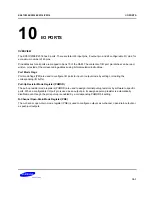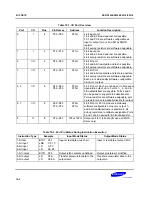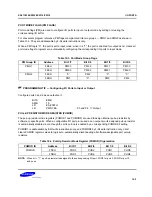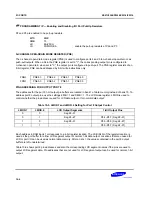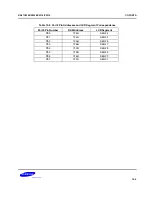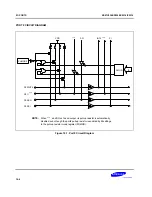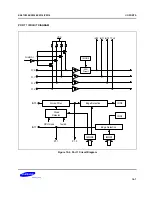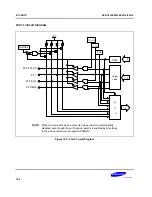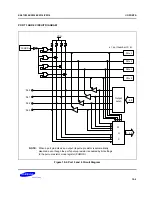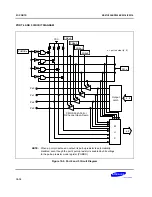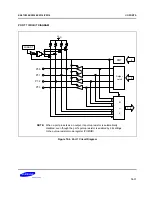
TIMERS and TIMER/COUNTERS
KS57C2308/P2308/C2316/P2316
11-2
BASIC TIMER (BT)
OVERVIEW
The 8-bit basic timer (BT) has five functional components:
— Clock selector logic
— 4-bit mode register (BMOD)
— 8-bit counter register (BCNT)
— 8-bit watchdog timer mode register (WDMOD)
— Watchdog timer counter clear flag (WDTCF)
The basic timer generates interrupt requests at precise intervals, based on the frequency of the system clock.
Basic timer’s counter register, BCNT, outputs timer pulses to the watchdog timer’s counter register, WDTCNT
when an overflow occurs in BCNT. You can use the basic timer as a "watchdog" timer for monitoring system
events or use BT output to stabilize clock oscillation when stop mode is released by an interrupt and following
RESET
. Bit settings in the basic timer mode register BMOD turns the BT on and off, selects the input clock
frequency, and controls interrupt or stabilization intervals.
Interval Timer Function
The measurement of elapsed time intervals is the basic timer's primary function. The standard interval is 256 BT
clock pulses.
To restart the basic timer, set bit 3 of the mode register BMOD to logic one. The input clock frequency and the
interrupt and stabilization interval are selected by loading the appropriate bit values to BMOD.2–BMOD.0.
The 8-bit counter register, BCNT, is incremented each time a clock signal is detected that corresponds to the
frequency selected by BMOD. BCNT continues incrementing as it counts BT clocks until an overflow occurs. An
overflow causes the BT interrupt request flag (IRQB) to be set to logic one to signal that the designated time
interval has elapsed. An interrupt request is then generated, BCNT is cleared to logic zero, and counting
continues from 00H.
Oscillation Stabilization Interval Control
Bits 2–0 of the BMOD register are used to select the input clock frequency for the basic timer. This setting also
determines the time interval (also referred to as “wait time”) required to stabilize clock signal oscillation when
power-down mode is released by an interrupt. When a
RESET
signal is generated, the standard stabilization
interval for system clock oscillation following a
RESET
is 31.3 ms at 4.19 MHz.
Watchdog Timer Function
The basic timer can also be used as a “watchdog” timer to detect an inadvertent program loop, that is, system or
program operation error. For this purpose, instruction that clears the watchdog timer (BITS WDTCF) within a
given period should be executed at proper points in a program. If an instruction that clears the watchdog timer is
not done within the period and the watchdog timer overflows, reset signal is generated and system is restarted
with reset status. An operation of watchdog timer is as follows:
— Write some value (except #5AH) to Watchdog Timer Mode register, WDMOD.
— Each time BCNT overflows, an overflow signal is sent to the watchdog timer counter, WDCNT.
— If WDTCNT overflows, system reset will be generated.
Summary of Contents for C2316
Page 30: ...ADDRESS SPACES KS57C2308 P2308 C2316 P2316 2 22 NOTES ...
Page 168: ...SAM47 INSTRUCTION SET KS57C2308 P2308 C2316 P2316 5 94 NOTES ...
Page 170: ......
Page 206: ...POWER DOWN KS57C2308 P2308 C2316 P2316 8 8 NOTES ...
Page 210: ...RESET KS57C2308 P2308 C2316 P2316 9 4 NOTES ...
Page 222: ...I O PORTS KS57C2308 P2308 C2316 P2316 10 12 NOTES ...
Page 272: ...LCD CONTROLLER DRIVER KS57C2308 P2308 C2316 P2316 12 24 NOTES ...
Page 280: ...SERIAL I O INTERFACE KS57C2308 P2308 C2316 P2316 13 8 NOTES ...
Page 294: ...MECHANICAL DATA KS57C2308 P2308 C2316 P2316 15 2 NOTES ...
Page 310: ...KS57P2308 P2316 OTP KS57C2308 P2308 C2316 P2316 16 16 NOTES ...
Page 318: ......
Page 320: ......
Page 322: ......
Page 325: ......
Page 327: ......


